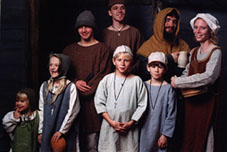Meet the Middle Ages
BackThe Peasants

As in the rest of Sweden, most people on Öland were peasants, leading the usual lives of farmers with sowing, harvesting, milking and tending livestock.
The farmers on Öland lived in villages, where the farm-houses lay in a row along the village road. Quite a few of these villages are still in the same place as in the Middle Ages.
Many of the farmers on Öland owned their own property and paid taxes to the Crown. They were free-holders. The gentry also owned land. Farmers who farmed this land were tenant farmers ( frälsebönder) - they leased the farm from the nobleman and paid taxes to him. The lease would usually be renewed every six years. When the lease was up for renewal, an additional fee was often claimed. It might have been rather more troublesome to have been a tenant farmer than a free-holder.
The villages on Öland would have had both tenant farmers and free-holders
The church, the bishop and the convents were land-owners, too. The farmers who leased this land were called church- bishop- or convent-farmers. The convents of Kalmar and Vadstena owned many farms on Öland. The convent in Nydala also had property on Öland. The Bishop of Linköping had several estates in the parish of Bredsättra. There he could control the lucrative herring fishery at Sikavarp.
In the summer of 1350, the Black Death struck Kalmar. By autumn, the plague had reached Öland. It returned time and time again; in 1363-66, in 11393-99, in 1404-06 and in 1411-16. Many people lost their lives, particularly in the wood-lands. More people survived the plague on Öland than in other parts of Kalmar County.